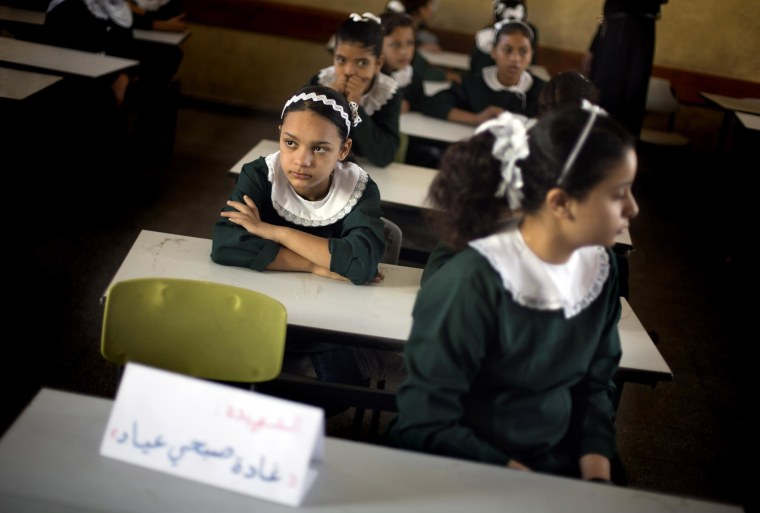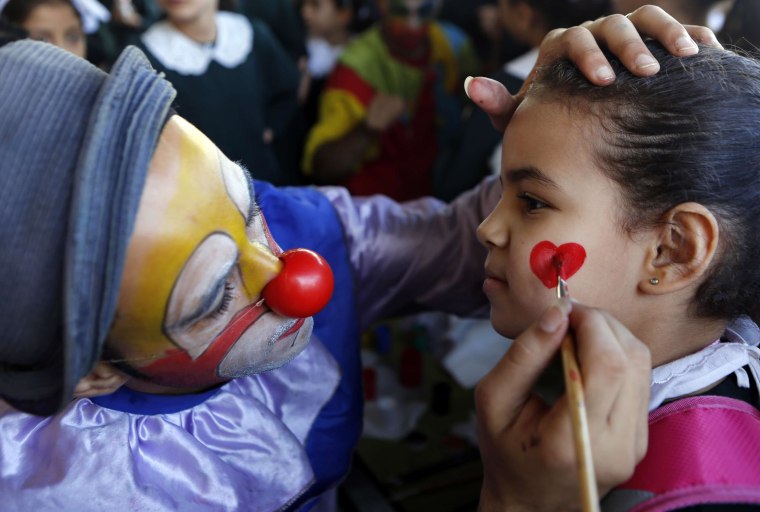GAZA CITY — In Gaza, there are children everywhere. Their voices float in through open windows even when you can't see them.
Just over half of the population here is under 18. Many of those young people were cooped up inside for more than 50 days this summer during Israel’s “Operation Protective Edge,” an offensive that left mosques, hospitals and schools flattened and more than 2,000 Palestinians dead, at least 500 of them children.
In the weeks of relative calm since an open-ended truce went into effect on Aug. 26 — after several cease-fires fell apart earlier in the conflict — children were allowed to venture out again. Days before school started you’d see them scrambling over rubble, often the ruins of their own homes, playing with siblings and friends.
Last Sunday, they headed back to the classroom.
On the first day of school in Gaza City, children in uniforms flooded the streets. The hunter green dresses with wide white collars of the government schools mingled with the navy blue and white striped dresses of the UN schools. UNRWA, the UN relief agency responsible for Palestinian refugees, administers the majority of the elementary and middle schools, while the government is responsible for a smaller number of those grade levels and for all Gaza high schools.
"No house in Gaza was free from fear and terror and the sounds of explosions"
Medhat Marzouk, a teacher at the Hassan el-Basri school, had a difficult job that Sunday morning. On July 16, four boys from the Bakr family were killed when two shells struck them as they played on the beach. The incident, which the Israel Defense Forces (IDF) says is being investigated, came to symbolize the overwhelming loss of innocent life in this last confrontation.
One of the four boys would have been in Marzouk’s fourth grade class this year, as well as another who was injured that day and is not yet back in school.
“No house in Gaza was free from fear and terror and the sounds of explosions,” said Marzouk. “Some [children] saw blood and death.” His job as a teacher is to try to “draw the war and the fear out of them,” he said. “Today we will hear from them, each one will talk about what happened to them during the war.”
Children here can tell you from looking at a destroyed house whether the projectile was from a drone, a tank or an F-16.
As children headed back to the classroom, the focus was much more on coping with what they’ve been through than on education or preparing them academically for the future. For the first week of school, there were no classes. Instead the days were devoted to psychosocial care and a chance for students to talk about their experiences during the offensive.
One boy playing on the beach at the time who survived the attack said as he looked back to see where the shell had landed he saw “white stuff” coming out of his friend’s skull.
Children are killed often enough in Gaza that there is an established protocol to mark their absence at schools. Usually, says Marzouk, students make a sign with the name of the dead student and place it on the desk where they used to sit, which is left empty. In classrooms more overcrowded than ever — with so many schools serving as shelters for the displaced, those in operation are running classes in double and even triple shifts — this gesture is particularly poignant.

Nearly 65,000 displaced people are still living in about 25 UN schools, says Pierre Krähenbühl, commissioner-general for the UNRWA.
In those school buildings where classes have resumed, “the symbol of reopening today was very important in terms of hope and reassurance that something at least is moving,” said Krähenbühl.
UN-run schools have employed 200 experienced counselors, whom they provided with additional training, to help support children starting back to school after a summer of violence. The next four or five weeks will be a “transitional phase” says Krähenbühl before easing back into the full curriculum. Teachers also received two days of training in how to offer psychosocial support.
In the government schools, where teachers only had four hours of training from counselors, there’s much more variation. Some schools will have only a week of psychosocial support and then turn directly to classes, while others will spend a few more weeks playing games and doing art projects before beginning in earnest.
The teachers have been through a lot, too.
“We as adults are psychologically damaged,” says Amani Ayyoub, who teaches English at a girls’ high school. As a part of the psychosocial training, teachers were told not to hit (which is not allowed during normal times either but sometimes happens), and not to shout even if students shouted at them.
Some Gaza residents observe that children’s games have gotten more violent since the summer. A favorite is “Israelis and Palestinians” — played a lot like “Cowboys and Indians” was in the 1950s United States.
Yet violent reactions weren’t what came up in Ayyoub’s classroom. She found that students didn’t want to discuss their experiences or remember the summer’s horrific events, even when pressed.
Schools give teachers lists of the children who have gone through particularly difficult times. There are many who have lost parents or their homes. Some 3,000 were wounded during the conflict, of which the UN estimates up to 1,000 may have long-term disabilities.
In the next two or three weeks, says Marzouk, his students will play a lot of games, put on plays and do art, slowly making the transition into the school year. “We wish we had more resources” to deal with the trauma, he adds.
Insufficient training can be a liability when working with traumatized children, doctors say, leading to retraumatization. Dr. Sami Oweida, a Gazan child psychologist, describes a scene from the aftermath of a previous war in which a teacher asked students to raise their hands if they had lost parents, then talked to the students about how their parents were martyrs. One child raised his hand and said his father had been shot by Hamas for being a collaborator.
Na’ma Baghout, 60, decided to keep her five grandchildren away from their school’s psychosocial support period. Instead she was taking them on a trip to Egypt, “so they don’t think about it,” she said, seated at the Rafah border crossing surrounded by kids between the ages of two and ten. Baghout said that the war terrified them and they have trouble sleeping.
“Sometimes you wonder whether the children are actually more traumatized or the parents are,” the UN’s Krähenbühl says. “There’s nothing worse as a parent than not to be able to protect your child in a period of extreme need.”

Rania el-Soussi, a community mental health worker, says parents tell her that in previous wars they would distract their children with games or drawing when the shelling started. But this time the shelling was too loud, too omnipresent, to ignore.
For some, even before the war, school did not feel like a safe place. Nesreen al-Najjar, 15, was walking with a friend one day near school when the friend was shot dead beside her. Al-Najjar’s school is in Khuzaa, a border area in the central Gaza Strip that was leveled in this summer’s offensive.
“In Gaza it’s not PTSD. There are ongoing traumatic events,” says Houweider. “It’s trans-generational trauma,” adds Dr. Akram Mossa, his colleague.
Mossa describes a 10-year-old girl who lost her little brother in an explosion. The girl says she prefers being asleep to being awake now, because when she dreams she gets to see him.
This story originally appeared at GlobalPost.
More From GlobalPost: